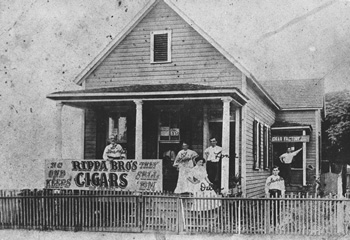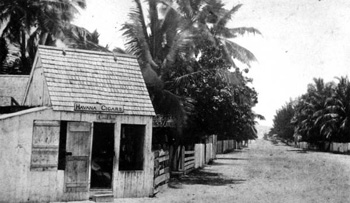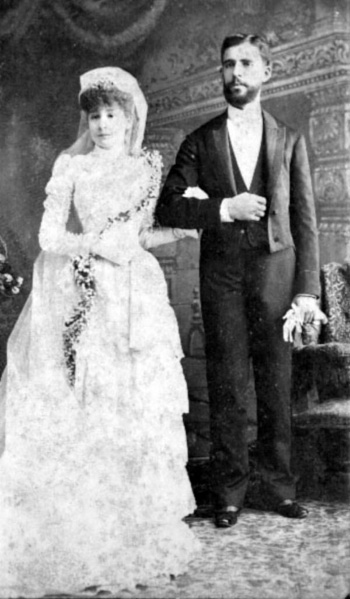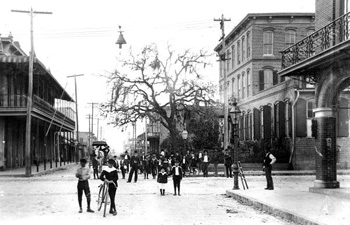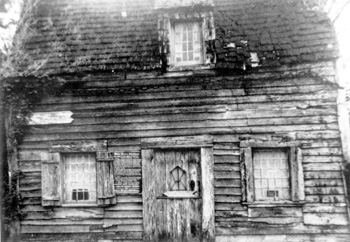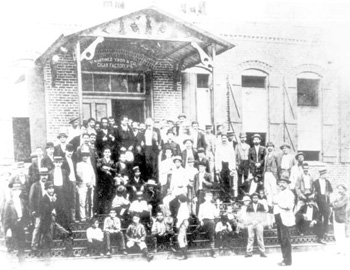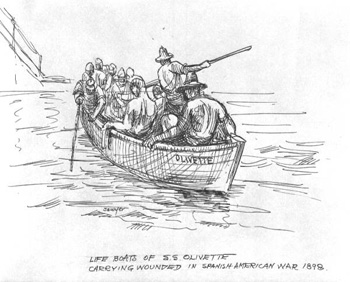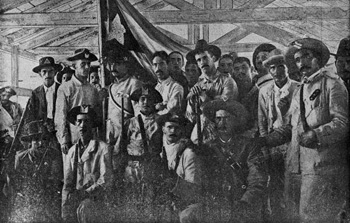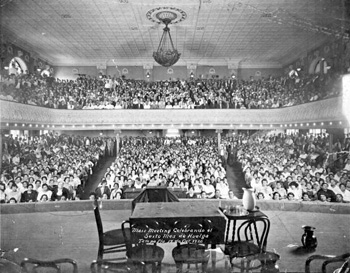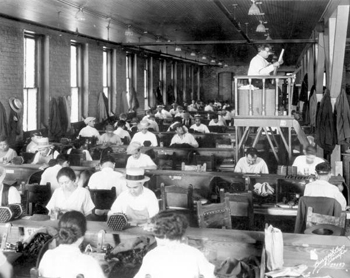The Cigar Industry Changes Florida
Photos and History
Cigar Making Comes to Florida
Commercial cigar rolling in Florida began with small-scale operations started by Cuban immigrants in the 1830s.
German immigrant and New York cigar manufacturer Samuel Seidenberg established the first “clear Cuban” cigar factory in Key West in 1867. By using Cuban laborers to roll Cuban tobacco, Seidenberg pioneered the idea of making authentic Cuban cigars in America while avoiding the high tariff levied against products from Havana, as well as the trade restrictions imposed by Spain.
There was a strong natural connection between the cigar workers in Key West and Havana, and by the early 1890s, 50,000-100,000 people traveled back and forth annually.
Rippa Bro's Cigars store and cigar factory (190-)
Image number: MS25987
Owned by David and Toba Rippa. Immigrated from Rumania to Key West in late 1880s. (Left to right): David, Toba, Adella, Larry, Jack and Harry.
Havana cigar shop: Key West, Florida (ca. 1900)
Image number: PR05966
Cuban Cigar Makers Create a New Florida City
Vicente Martinez Ybor, one of the most significant figures in the history of cigar making in Florida, established a cigar factory in Key West in 1869. Ybor had run a very successful cigar manufacturing business in Cuba, but he fled the country after colonial authorities discovered his connections with revolutionaries.
In 1885, he moved his cigar making operation from Key West to Tampa. Steamships could bring tobacco leaves from Cuba for the cigar factories, and Henry Plant's new railroad connected the small town of Tampa to the rest of the country. The area around the cigar factories grew and became known as Ybor City.
Immigrants came not just from Cuba, but from Italy, Spain, and throughout Eastern Europe and Latin America in search of work. At its height in the 1880s, there were more than 100 factories in Key West. By 1910, there were 150 factories in the Tampa area employing more than 10,000 workers. Of the 50,000 residents of Tampa, 14,000 were Cuban, 7,500 were Spanish, and 1,500 were Italian.
Jenny and Ygnacio Castaneda on their wedding day (1890)
Image number: N045400
Jenny was the daughter of Vicente Martinez Ybor. Vicente, with the help of personal underwriting by the members of the Tampa Board of Trade, bought 40 acres for $4,000 in 1885, built the first cigar factory in the area and moved his cigar making operation from Key West to Tampa. He brought workers from Cuba to work in his factory, and also built and rented houses to them. The area grew and became known as Ybor City.
Havana-American cigar factory in Ybor City: Tampa, Florida (19--)
Image number: RC09169
At the intersection of 14th Street and 9th Avenue in Ybor City.
Mutual Aid Societies
Mutual aid societies were central to the culture of the new Florida communities. Cubans, Spaniards, Italians and Germans formed clubs where members and their families could socialize, attend performances and dances, play cards and dominoes, and receive free medical services.
The Cuban clubs were also an important source of fundraising and political support for the Cuban revolutionary movement.
Three views of ethnic social clubs from the area: Tampa, Florida (19--)
Image number: N043529
Note from top of picture: "The social clubs, then as now, play a great part in preserving the customs and traditions of the Latin people…"
Note from caption accompanying top image: "Membership campaign picnic - Italian Club, Tampa, Florida - May 18, 1924 Philip F. Licata, President."
Note under bottom left image: "Cuban Club Dance - 1912."
Note under bottom right image: "Spanish Club Sanatorium."
Paulina Pedroso (18--)
Image number: N043603
From the 1880s to 1910, Paulina Pedroso and her husband Ruperto worked at cigar making while organizing La Sociedad Libres on behalf of Cuban freedom. José Martí headquartered his activities in the United States in her home in Ybor City.
The Paulina Pedroso home at the corner of 8th Avenue and 13th Street, Ybor City: Tampa, Florida (18--)
Image number: RC10808
José Martí at the Vicente Martinez Ybor cigar factory, where he made one of his most famous speeches for Cuban independence: Ybor City, Florida (between 1890 and 1895)
Image number: RC07469
José Martí is in the center of the photograph on the top step with his jacket open and his hands in his pockets. Photographed on the iron steps of the Vicente Martinez Ybor cigar factory, where he made one of his most famous speeches to supporters of the Cuban revolutionary movement.
The Spanish-American War and Cuban Independence
Florida's Cuban immigrants were strong supporters of the United States' involvement in the Spanish-American War. Cuban-Americans from every social and economic level supported the cause of Cuban independence. Revolutionary leader José Martí toured Ybor City, West Tampa and Key West, delivering speeches to large crowds wherever he went.
Olivette life boat carrying wounded in Spanish-American War, 1898, drawn by Philip Ayers Sawyer
Image number: N047356
The Olivette was built for the Tampa to Key West to Havana run in the winter and the Boston to Bar Harbor, Maine, run in the summer and fall. It brought tobacco out of Cuba for Tampa cigar factories just prior to an embargo. The Olivette brought the survivors of the Maine back to the United States. She helped evacuate American citizens from Cuba.
Cuban volunteers in the barracks (1898)
Image Number: N041306
Note from caption: "Cuban volunteers in their barracks. Many of these were cigar makers at Tampa."
The "Army of the Cuban Republic" was made up of 40 Cubans from Jacksonville, 200 from New York, and 150 from Key West. They set sail on the Florida to join the rebels on May 21.
Workers Versus the Management
By 1889, strikes and organized resistance to factory demands were commonplace. Over the next two decades, cigar workers became increasingly organized and held strikes more frequently. This helped push more of the cigar manufacturers to leave Key West, most of them resettling in the Tampa Bay area.
Mass meeting of cigar workers on strike: Tampa, Florida (1920)
Image number: PR12441
Mass meeting celebrating the sixth month of the strike by cigar workers.
The Lector
Strong union culture was an essential aspect of the Cuban cigar factory, upon which many of the Florida factories were modeled.
The Lector was a factory worker usually selected by fellow workers to read aloud during work hours to help pass the time and keep the workers’ minds occupied. Although the Lectors read all sorts of materials from fiction to news articles, choices were often very pro-union, in favor of Cuban independence, and in Tampa, increasingly leftist and anti-corporation. By 1931, after years of dispute over the role of Lectors in changing factories, the major Tampa companies banned them once and for all.
Lector in a large cigar factory: Tampa, Florida (ca. 1900)
Image number: RC03558

 Listen: The World Program
Listen: The World Program